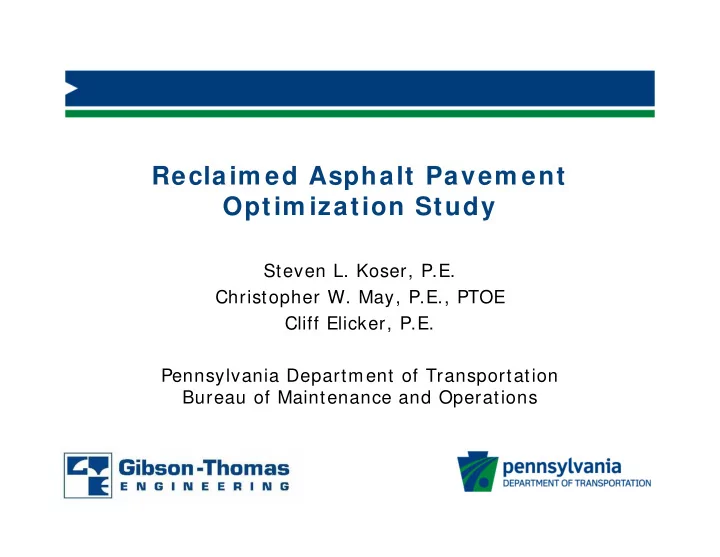

Click to edit Master title style Reclaim ed Asphalt Pavem ent Optim ization Study Steven L. Koser, P.E. Christopher W. May, P.E., PTOE Cliff Elicker, P.E. Pennsylvania Department of Transportation Bureau of Maintenance and Operations August 2, 2017
PennDOT Pavement Advisory Group • PAG formed by DS Highway Administration 2015 • Members – PAPA, APC, PACA, ACPA, FHWA, ACEC, PTC, PennDOT • PAG Picked “Top 10” Pavement Initiatives • PAPA had 4 initiatives in “Top 10” – Long Life Asphalt Pavement – Reduced # of Asphalt Job Mix Formulas – Asphalt Pavement PWL Spec – Recycled Asphalt Pavement Issues
PennDOT Pavement Advisory Group • Recycled Asphalt Pavement Issues – Perform a study to ascertain “What is the Highest and Best Use of RAP and Develop a Policy on Usage Priorities” – PAPA drafted Research Proposal “Optimizing the Utilization of Reclaimed Asphalt Pavements”– gave to PennDOT
PennDOT RAP Study • PennDOT RAP Study: – Consultant selected and study underway – Study - Policy to recycle RAP (highest and best use) – Six month study with monthly status meetings • Statewide RAP Study: – Research other State DOT’s laws, policies, and procedures – Develop “Best Practices” document – Study Potential for Transport (economically feasible and practical) – Develop Final Report and Update/ Implement Policies (as needed)
PennDOT Current RAP Policy • SOL 495-17-02 “Milled Asphalt Pavement Material: Retainage, Plan and Use” January 26, 2017 – Retainage – PennDOT Owns material – PennDOT may offer RAP to contractors – PennDOT must track all RAP – SRL & Stockpile Management
RAP SOL Retainage & Use • “ SOL 495-17-04 “Milled Material Retainage and Use” March 10, 2017 – Contractor Retainage – Minimum, 15% of millings* – Contractor Retainage – < 200 tons millings generated * SOL States – District should consider > 15% if higher RAP mix proposed by contractor
Click to edit Master title style Reclaim ed Asphalt Pavem ent Optim ization Study Prepared for Pennsylvania Department of Transportation Bureau of Maintenance and Operations August 2, 2017
Purpose and Background • RAP stockpile surpluses • Goals: – Research Best Practices – Research Transportation – Implementation Strategies
Approach • Technical Steering Committee PennDOT BOMO PennDOT District 1-0 PennDOT BOPD PennDOT District 6-0 PennDOT Executive Office PennDOT District 10-0 PennDOT Materials personnel PennDOT District 11-0 • Monthly Steering Committee Meetings • Questionnaires • Interviews • Literature
District RAP Use – Current and Future • Average RAP Usage • Cold recycling • Full Depth Pavement & Shoulders • Shoulder backup • Other potential uses include: Trench backfill Pothole patching Vegetation management Rock lining Stockpile site enhancements Seal coating (# 8 aggregate) Slide/ sink hole restoration
District RAP Use – Current and Future • Transportation • Future projections • Strategies identified for future RAP usage • Environmental Concerns
Other State DOTs RAP Use • Questionnaires • RAP Percentages • Environmental Concerns
Academic Literature Review • Studies Reviewed • Study Finding Summary • Penn State Study – Best Practices for the Design, Evaluation and Quality Control of High Percentage RAP Mixes
International RAP Information • Studies Reviewed • Study Finding Summary
Coordination with Municipalities • Statewide Practices • Municipal RAP usage: • Roadblocks to PennDOT/ municipal coordination:
Asphalt Producers • Transport • % RAP in new pavement • RAP Stockpiles • Roadblocks to Higher Percentage RAP Usage • Performance Testing
Potential RAP Uses • Uses other than in new pavement mixtures: • 1 st use should be new pavement mixtures • All other uses are acceptable secondary uses, particularly in times of excess
Short-term Recommendations 1. Implement recommendations of the Penn State Study (RBR ratio tier system) 2. Use RAP as a material extender while maintaining the hierarchy of use (RAP in new pavements 1 st use, other uses 2 nd ) 3. Maximize the use of cold recycling (in-place and central plant) 4. Utilize RAP in thin mix overlays for the secondary roadway network 5. Each District should determine primary RAP use and if segregation for those uses is beneficial. Consider segregating millings by type (PG 64 & PG 58) and SRL. 6. Implement the following best practices: – Require fractionation for high RAP use – Require covered RAP stockpiles and processing to minimize moisture – Require longer mixing times – Use rejuvenators, softening binders, etc. to facilitate high RAP mixtures – Change production processes - longer virgin aggregate and RAP mix times, high shear mixing, and storage time 7. Develop inter-District coordination to maximize RAP use. 8. Use in-line roller crushers or reduced speed impact crushers to avoid changing RAP gradation when breaking up clumps of RAP. Screen material before it’s crushed to avoid putting anything through the crusher that isn’t necessary.
Long-term Recommendations 1. Each District should develop a 3 year (minimum), 5 year preferred, overall plan to coordinate mill/ overlay projects to minimize transport, minimize storage time, efficiently schedule maintenance force, and match high SRL millings with high SRL overlays. 2. Develop and implement performance testing requirements to replace RBR ratio tier system. 3. Develop coordination programs between the Department, contractors, producers, and local municipalities and counties to identify needs and share materials and services. Develop educational opportunities about RAP for municipalities. 4. Develop less strict material and service sharing requirements between all entities. May require legislative changes to maximize sharing of material.
Questions & Com m ents Chris May chris.may@Gibson-thomas.com Cliff Elicker cliff.Elicker@Gibson-Thomas.com
Recommend
More recommend